A Japanese garden is designed to evoke a sense of tranquility, balance, and connection with nature. Carefully selected plants play a crucial role in achieving this peaceful aesthetic, offering graceful textures, seasonal beauty, and a harmonious flow.
From delicate maples to lush moss and elegant flowering shrubs, the right combination of plants can transform any space into a serene retreat. In this article, we explore 14 must-have plants for a Japanese garden that will help you create a calming, meditative outdoor sanctuary.
Sakura (Cherry Blossom)
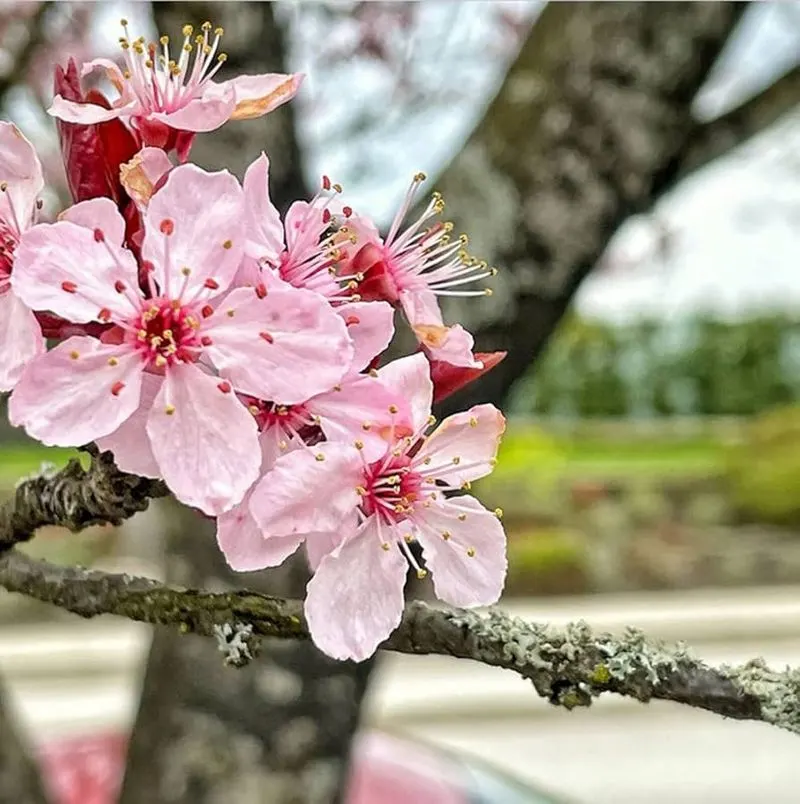
Known for their breathtaking beauty, cherry blossoms bring a sense of serenity and elegance. The delicate pink flowers bloom in early spring, creating a stunning visual. Plant them in well-drained soil and ensure they receive ample sunlight for optimal growth. Integrating a Sakura tree in your garden symbolizes the fleeting nature of life, encouraging mindfulness. As the petals gracefully fall, a poetic atmosphere is created, inviting reflection. Cherry blossoms are not only visually appealing but also emotionally enriching, making them a quintessential addition to any Japanese garden.
Bamboo

Bamboo is synonymous with strength and flexibility. Its tall, swaying stalks add vertical interest and a soothing rustle to your garden. Opt for clumping varieties to prevent invasive spread. Position bamboo plants to create natural screens, enhancing privacy. Their evergreen nature provides year-round greenery, crucial for maintaining the garden’s tranquil appeal. Regular maintenance ensures their controlled growth, avoiding any aggressive tendencies. Utilize bamboo in combination with other plants for a balanced aesthetic. Its presence instills a sense of calm and order, essential for a peaceful garden retreat.
Japanese Maple
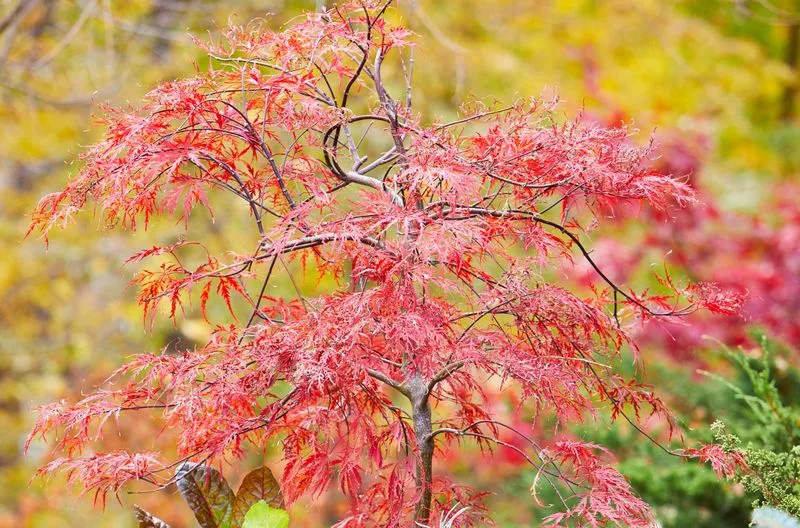
Japanese maples captivate with their intricate leaf patterns and vibrant colors. These trees offer dynamic beauty, changing hues with the seasons. Plant them in a sheltered spot with dappled sunlight for best results. Their compact size suits smaller gardens, while various cultivars provide options in foliage shapes and colors. Incorporate them near water features or pathways for an artistic touch. These trees symbolize grace and elegance, enhancing the garden’s contemplative nature. Their autumn display is particularly spectacular, offering a breathtaking visual experience.
Moss
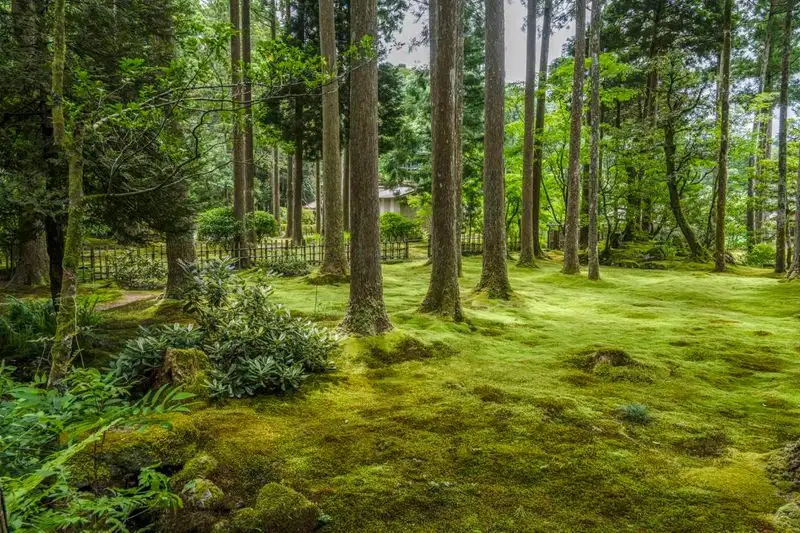
Moss adds a sense of antiquity and calm, offering a soft, green blanket over stones and soil. It thrives in shady, moist areas, making it perfect for ground cover. This plant requires minimal maintenance, allowing you to focus on other garden aspects. Moss softens hard landscapes, creating a seamless blend with natural elements. Its presence encourages quiet reflection, embodying the essence of a Japanese garden. Use moss to cover unsightly areas or to create a serene, aged look. Its subtle beauty is both understated and profound.
Azalea
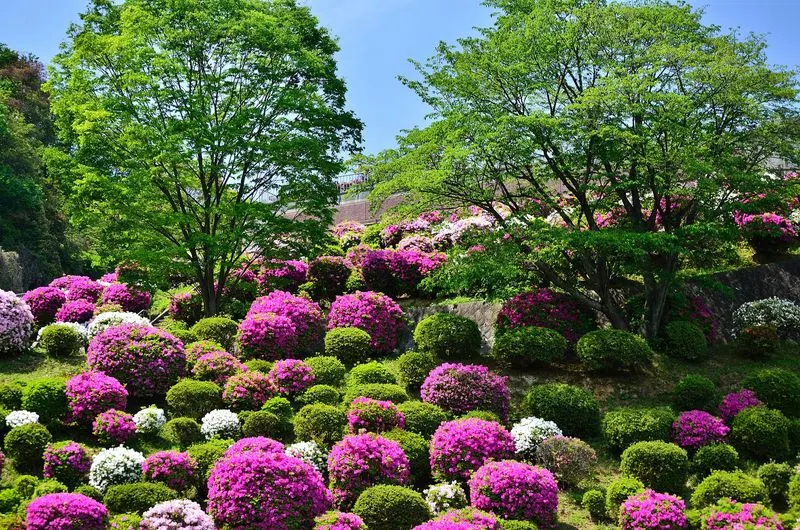
Azaleas bring bursts of color with their vivid blooms, appearing in spring and sometimes again in fall. These shrubs flourish in acidic soils and partial shade. Group them in clusters for dramatic effect, allowing their colors to complement each other. Prune after blooming to maintain their shape and encourage healthy growth. Azaleas’ rich palette and lush foliage create impactful visual contrast against other plants. Their vibrant presence enhances the garden’s seasonal transitions, providing dynamic beauty throughout the year. They are a symbol of abundance and beauty in Japanese culture.
Lotus
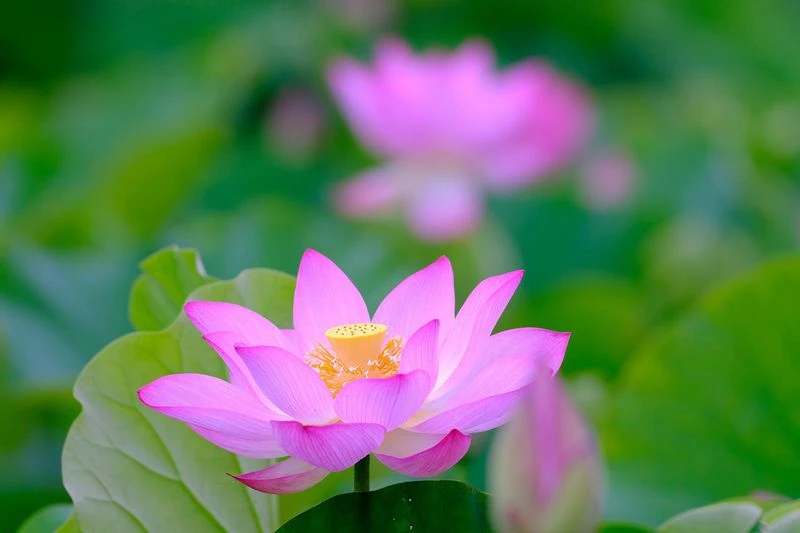
Lotus flowers, with their large, fragrant blooms, are a symbol of purity and enlightenment. They flourish in ponds, bringing elegance to water features. Plant them in containers submerged in water for easy maintenance. The sight of lotus flowers opening in the morning sun is mesmerizing, offering a daily moment of reflection. Their life cycle symbolizes rebirth and spiritual awakening, themes central to Japanese gardens. The combination of their striking beauty and profound symbolism enhances the garden’s peaceful ambiance. Integrate lotus near seating areas for contemplative relaxation.
Hosta
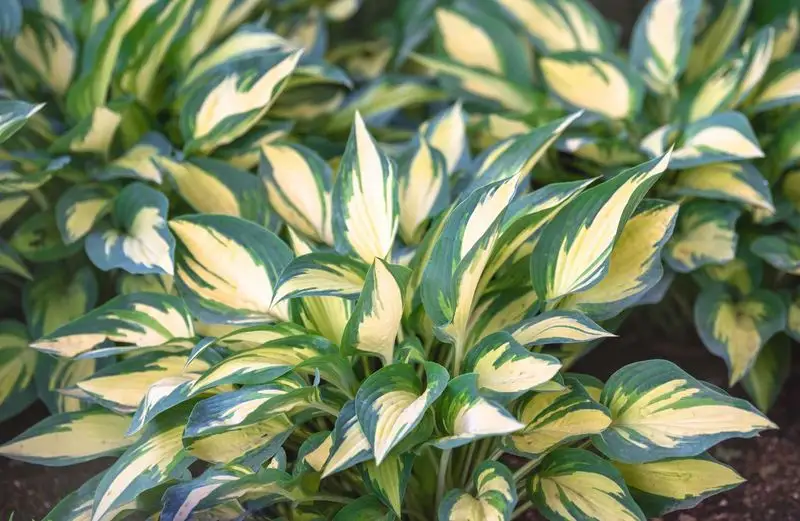
Hostas are valued for their lush foliage and ability to thrive in shade. Their large, textured leaves provide a striking contrast to more delicate plants. These perennials require minimal care, making them ideal for low-maintenance gardens. Position hostas in groupings to create depth and interest. The variety in leaf color and pattern adds visual richness to shaded areas. Hostas’ presence in a garden brings a sense of calm and stability, aligning with the tranquil nature of Japanese garden design. They’re perfect for adding structure and form.
Iris
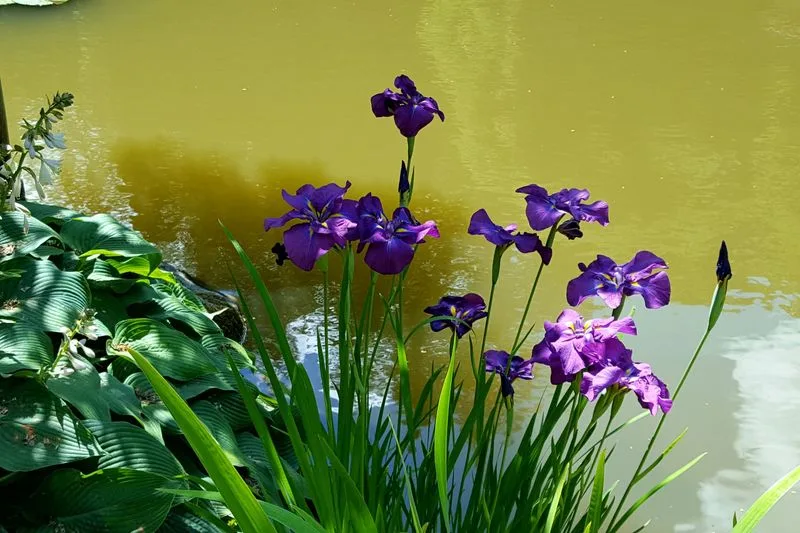
Iris flowers captivate with their intricate shapes and vibrant hues. Blooming in late spring, they add a striking splash of color. Plant them in sunny locations, ideally near water features where they thrive. Their sword-like foliage provides structure even when not in bloom. Irises symbolize hope and cherished friendships, making them meaningful additions. Their elegance and easy maintenance make them suitable for both novice and experienced gardeners. These flowers create a harmonious connection between land and water, essential in Japanese gardens, and enrich the visual tapestry with their beauty.
Camellia
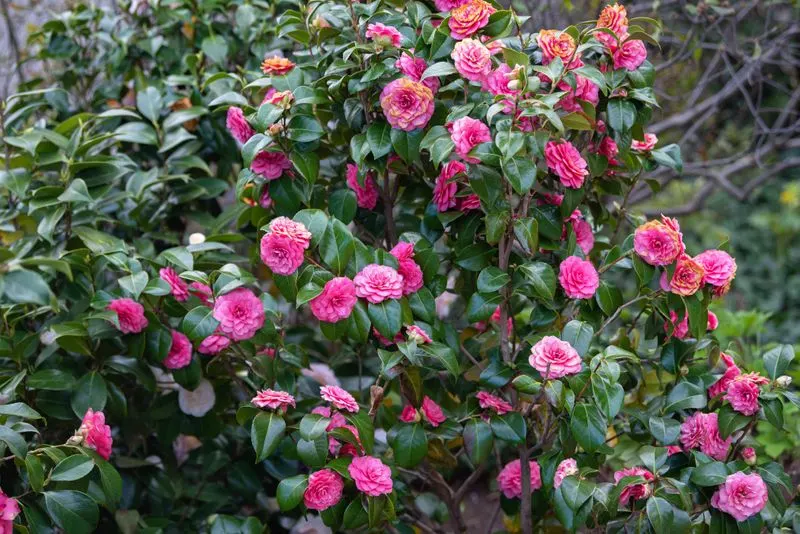
Camellias are prized for their exquisite blooms and glossy leaves. Flowering in late winter to early spring, they bring color when few other plants do. Plant them in well-drained, acidic soil with partial shade for optimal growth. The blooms are showy yet elegant, offering a beautiful contrast to evergreen foliage. They symbolize admiration and perfection, enriching the garden’s narrative. Camellias require moderate care but reward with stunning visual impact. Their presence enhances the garden’s year-round beauty, making them a cherished choice for any peaceful retreat.
Pine
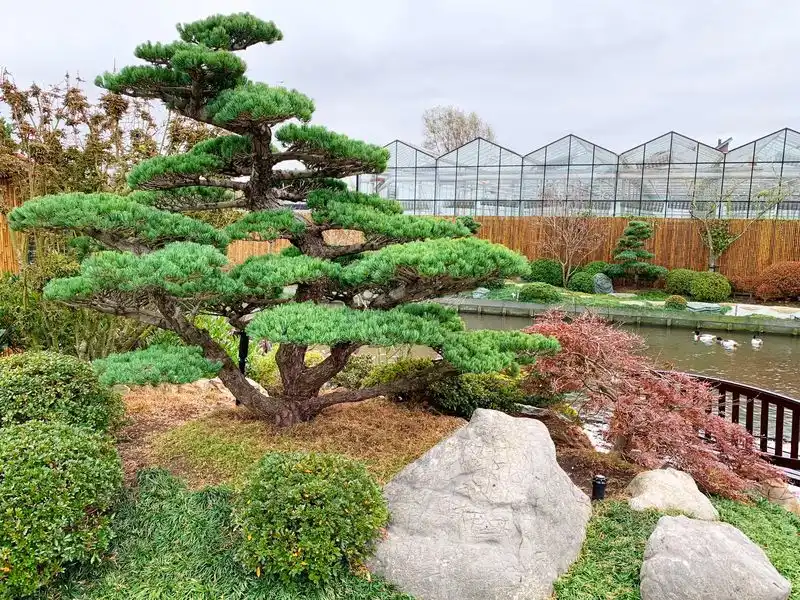
Pines are a quintessential element in Japanese gardens, representing longevity and steadfastness. Their evergreen needles and sculptural form add year-round interest. Use them to frame views or as focal points within the garden. The textured bark and twisted branches create visual intrigue. Pines require well-drained soil and minimal pruning, making them relatively low-maintenance. Their ability to withstand harsh conditions symbolizes resilience. Incorporate them alongside rocks or water features for a naturalistic design. Pines’ stately presence and symbolic meaning make them an essential part of any Japanese garden.
Ferns

Ferns bring delicate texture and a lush, green backdrop to shaded areas. Their feathery fronds complement the more solid elements of a garden. Place them in moist, well-drained soil to ensure healthy growth. Ferns are low-maintenance, thriving in spots where other plants struggle. Use them to soften the edges of paths or ponds, enhancing the natural feel. Their presence adds a timeless quality, echoing the tranquility of Japanese garden aesthetics. These graceful plants are perfect for creating a serene, enveloping atmosphere.
Japanese Wisteria
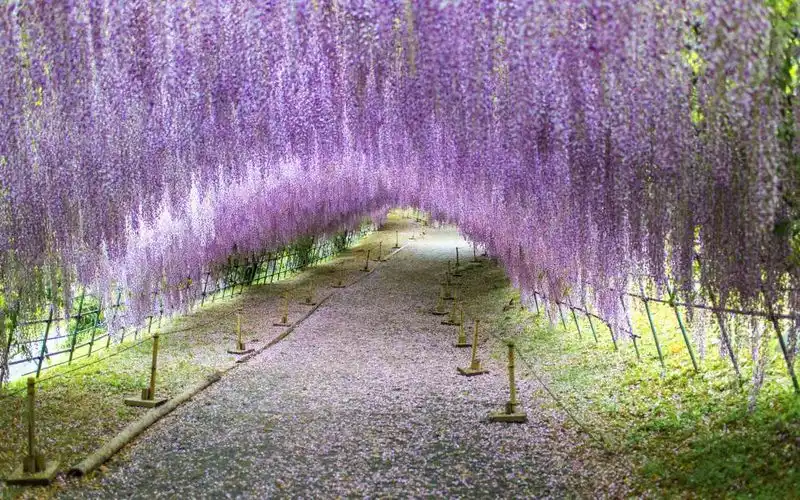
Wisteria vines are known for their dramatic flowering displays. Their cascading clusters of purple blooms are a sight to behold. Plant them in sunny locations with sturdy supports like pergolas or arches. Pruning is essential to control their vigorous growth and encourage flowering. Wisterias symbolize love and longevity, adding depth to the garden’s story. Their long, trailing blooms create stunning visual spectacles in spring. Integrate them into entrances or over walkways for a breathtaking experience. These vines combine beauty and history, enhancing the garden’s allure.
Chrysanthemum

Chrysanthemums, or “kiku” in Japanese, are celebrated for their abundant blooms and significance in Japanese culture. Flowering in autumn, they add a burst of color when many plants are fading. Plant them in well-drained soil with full sun exposure. Their layered petals and diverse colors create striking displays. Chrysanthemums symbolize longevity and rejuvenation, enriching the garden’s seasonal narrative. Arrange them in groups for dramatic effect, allowing their bright hues to shine. These flowers bring vibrant energy and cultural depth, making them indispensable for a complete Japanese garden.
Peony
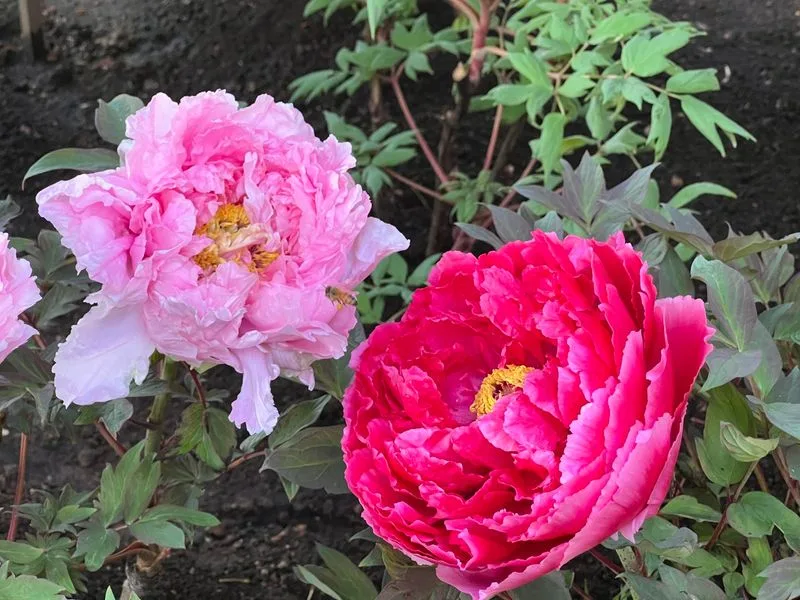
Peonies are beloved for their lush, fragrant blooms and elegance. Flowering in late spring, they provide a stunning display. Plant them in well-drained soil with ample sunlight for best results. Peonies’ rich history and symbolism of honor and prosperity make them meaningful additions. Their large blossoms are breathtaking, offering visual and olfactory delight. These plants require some care but reward with spectacular beauty. Position peonies where their fragrance and color can be appreciated, enhancing the garden’s sensory experience and adding to its overall charm.

